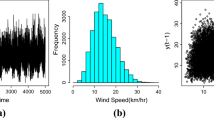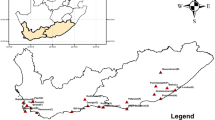Abstract
Strong wind and rainfall induced by extreme meteorological processes such as typhoons have a serious impact on the safety of bridges and offshore engineering structures. A new bivariate compound extreme value distribution is proposed to describe the probability dependency structure of annual extreme wind speed and concomitant process maximum rainfall intensity in typhoon-affected area. This probability model takes full account of the case that there may be no rainfall in a typhoon process. A case study based on the observation data of typhoon maximum wind speed and maximum rainfall intensity in Shanghai is conducted to testify the efficiency of the model. Weibull distributions with two parameters are applied to fit respective probability margins, and the joint probability distribution is constructed by Gumbel–Hougaard copula. The fitting results and K–S tests show that these models describe the original data well. The joint return periods are calculated by Poisson bivariate compound extreme value distribution we have proposed. They indicate that typhoons with no rain have smaller joint return periods, and wind speed is the main factor which impacts the change of the joint return periods.





Similar content being viewed by others
Abbreviations
- BCEVD:
-
Bivariate compound extreme value distribution
- JRP:
-
Joint return period
- UCEVD:
-
Univariate compound extreme value distribution
References
Blocken C, Carmeliet J (2004) A review of wind-driven rain research in building science. J Wind Eng 92:1079–1130
Bottema M (1993) Wind climate and urban geometry. Technical University of Eindhoven, Fago
Castorrini A, Corsini A, Rispoli F, Venturini P, Takizawa K, Tezduyar TE (2016) Computational analysis of wind-turbine blade rain erosion. Comput Fluids 141:175–183
Choi ECC (2001) Wind-driven rain and driving rain coefficient during thunderstorms and non-thunderstorms. J Wind Eng Indus Aerodyn 89:293–308
Corbella S, Stretch DD (2013) Simulating a multivariate sea storm using archimedean copulas. Coast Eng 76:68–78
de Waal DJ, van Gelder PHAJM (2005) Modelling of extreme wave heights and periods through copulas. Extremes 8:345–356
Dong S (2007) Combination of extreme wind speed and wave height for offshore structure design. Sea Technol 48(4):10–13
Dong S, Wang NN, Liu W, Guedes Soares C (2013) Bivariate maximum entropy distribution of significant wave height and peak period. Ocean Eng 59:86–99
Dong S, Tao SS, Li X, Guedes Soares C (2015) Trivariate maximum entropy distribution of significant wave height, wind speed and relative direction. Renew Energy 78:538–549
Fukutani Y, Anawat S, Imamura F (2016) Uncertainty in tsunami wave heights and arrival times caused by the rupture velocity in the strike direction of large earthquakes. Nat Hazards 80(3):1749–1782
Hikami Y, Shiraishi N (1988) Rain-wind induced vibration of cables stayed bridges. J Wind Eng Indus Aerodyn 29(1/2/3):409–418
Jonathan P, Flynn J, Ewans K (2010) Joint modelling of wave spectral parameters for extreme sea states. Ocean Eng 37:1070–1080
Kereszturi M, Tawn J, Jonathan P (2016) Assessing extremal dependence of North Sea storm severity. Ocean Eng 118:242–259
Lacasse MA, Vanier DJ (1999) Durability of building materials and components 8: service life and asset management. Service Life and Durability of Materials and Components. NRC Research Press, Ottawa
Lebrun R, Dutfoy A (2009) A generalization of the Nataf transformation to distributions with elliptical copula. Probab Eng Mech 24:172–178
Liu DF, Wen SQ, Wang LP (2002) Compound bivariate extreme distribution of typhoon induced sea environments and its application. In: Proceedings of the 12th international offshore and polar engineering conference, May 26–31, 2002, Kitakyushu
Liu DF, Pang L, Fu G, Shi HD, Fan W (2006) Joint probability analysis of hurricane Katrina 2005. In: Proceedings of the 16th international offshore and polar engineering conference, May 28–June 2, 2006, San Francisco
Louie H (2014) Evaluation of bivariate Archimedean and elliptical copulas to model wind power dependency structures. Wind Energy 17(2):225–240
Lucas C, Guedes Soares C (2015) Bivariate distributions of significant wave height and mean wave period of combined sea states. Ocean Eng 106:341–353
Mínguez R, Tomás A, Méndez FJ, Medina R (2013) Mixed extreme wave climate model for reanalysis databases. Stoch Env Res Risk Assess 27(4):757–768
Monbet V, Prevosto M (2001) Bivariate simulation of non stationary and son Gaussian observed processes: application to sea state parameters. Appl Ocean Res 23(3):139–145
Montes-Iturrizaga R, Heredia-Zavoni E (2015) Environmental contours using copulas. Appl Ocean Res 52:125–139
Montes-Iturrizaga R, Heredia-Zavoni E (2016) Multivariate environmental contours using C-vine copulas. Ocean Eng 118:68–82
Nelsen RB (2006) An introduction to copulas. Springer, New York
Park JB, Kal BS, Heo JR (2015) The study to estimate the fitness of bivariate rainfall frequency analysis considering the interdependence between rainfall and wind speed. J Korean Soc Hazard Mitig 15(2):103–110
Silva-González F, Heredia-Zavoni E, Montes-Iturrizaga R (2013) Development of environmental contours using Nataf distribution model. Ocean Eng 58:27–34
Tao SS, Dong S, Wang NN, Guedes Soares C (2013) Estimating storm surge intensity with Poisson bivariate maximum entropy distributions based on copulas. Nat Hazards 68:791–807
Tawn JA (1990) Modelling multivariate extreme value distributions. Biometrika 77(2):245–253
Vanem E (2016) Joint statistical models for significant wave height and wave period in a changing climate. Marine Struct 49:180–205
Vinayagamurthy G, Liu QK, Zheng YF, Masahiro M, Yukio T (2013) Effect of wind speed, wind direction, rainfall intensity, damping and cable diameter on vibration amplitude of the cable. The Eighth Asia-Pacific Conference on Wind Engineering, December 10–14, 2013, Chennai
Wu ZK, Zhao L, Ge YJ (2010) Statistical analysis of wind velocity and rainfall intensity joint probability distribution of Shanghai area in typhoon condition. Acta Aerodyn Sinica 28(4):393–399
Acknowledgements
The study was partially supported by the National Natural Science Foundation of China (Nos. 51479183, 51509227), the National Key Research and Development Program, China (Nos. 2016YFC0303401, 2016YFC0802301) and the Shandong Province Natural Science Foundation, China (No. ZR2014EEQ030).
Author information
Authors and Affiliations
Corresponding author
Rights and permissions
About this article
Cite this article
Dong, S., Jiao, CS. & Tao, SS. Joint return probability analysis of wind speed and rainfall intensity in typhoon-affected sea area. Nat Hazards 86, 1193–1205 (2017). https://doi.org/10.1007/s11069-016-2736-8
Received:
Accepted:
Published:
Issue Date:
DOI: https://doi.org/10.1007/s11069-016-2736-8




